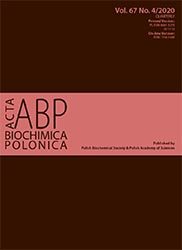Fibroblast to myofibroblast transition is enhanced in asthma-derived fibroblasts in comparison to fibroblasts derived from non-asthmatic patients in 3D in vitro cultures due to Smad2/3 signalling
Abstract
The basic hallmarks of bronchial asthma, one of the most common chronic diseases occurring in the world, are chronic inflammation, remodelling of the bronchial wall and its hyperresponsiveness to environmental stimuli. It was found that the fibroblast to myofibroblast transition (FMT), a key phenomenon in subepithelial fibrosis of the bronchial wall, was crucial for the development of asthma. Our previous studies showed that HBFs derived from asthmatic patients and cultured in vitro display some inherent features which facilitate their TGF-β-induced FMT. Although usefulness of standard ‘2D’ cultures is invaluable, they have many limitations. As HBFs interact with extracellular matrix proteins in the connective tissue, which can affect the FMT potential, we have decided to expand our ‘2D’ model to in vitro cell cultures in 3D using collagen gels. Our results show that 1.5 mg/ml concentration of collagen is suitable for HBFs growth, motility, and phenotypic shifts. Moreover, we demonstrate that in the TGF-β1-activated HBF populations derived from asthmatics, the expression of fibrosis-related genes (ACTA2, TAGLN, SERPINE1, COL1A1, FN1 and CCN2) was significantly increased in comparison to the non-asthmatic ones. We also confirmed that it is related to the TGF-β/Smad2/3 profibrotic pathway intensification. In summary, the results of our study undoubtedly demonstrate that HBFs from asthmatics have unique intrinsic features which predispose them to increased FMT under the influence of TGF-β1, regardless of the culture conditions.
Acta Biochimica Polonica is an OpenAccess quarterly and publishes four issues a year. All contents are distributed under the Creative Commons Attribution-ShareAlike 4.0 International (CC BY 4.0) license. Everybody may use the content following terms: Attribution — You must give appropriate credit, provide a link to the license, and indicate if changes were made. You may do so in any reasonable manner, but not in any way that suggests the licensor endorses you or your use.
Copyright for all published papers © stays with the authors.
Copyright for the journal: © Polish Biochemical Society.


